tow Citroen C3 PICASSO RHD 2014 1.G User Guide
[x] Cancel search | Manufacturer: CITROEN, Model Year: 2014, Model line: C3 PICASSO RHD, Model: Citroen C3 PICASSO RHD 2014 1.GPages: 288, PDF Size: 8.38 MB
Page 92 of 288
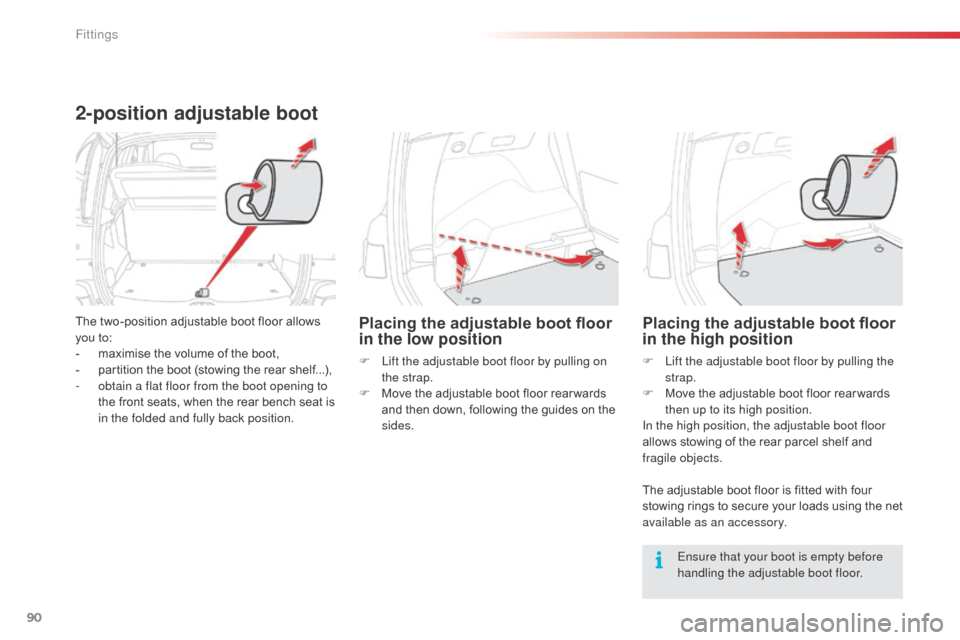
90
2-position adjustable boot
The two-position adjustable boot floor allows
you to:
-
m
aximise the volume of the boot,
-
p
artition the boot (stowing the rear shelf...),
-
o
btain a flat floor from the boot opening to
the front seats, when the rear bench seat is
in the folded and fully back position.Placing the adjustable boot floor
in the low position
F Lift the adjustable boot floor by pulling on the strap.
F
M
ove the adjustable boot floor rear wards
and then down, following the guides on the
sides.
Placing the adjustable boot floor
in the high position
F Lift the adjustable boot floor by pulling the strap.
F
M
ove the adjustable boot floor rear wards
then up to its high position.
In the high position, the adjustable boot floor
allows stowing of the rear parcel shelf and
fragile objects.
The adjustable boot floor is fitted with four
stowing rings to secure your loads using the net
available as an accessory.
Ensure that your boot is empty before
handling the adjustable boot floor.
Fittings
Page 93 of 288
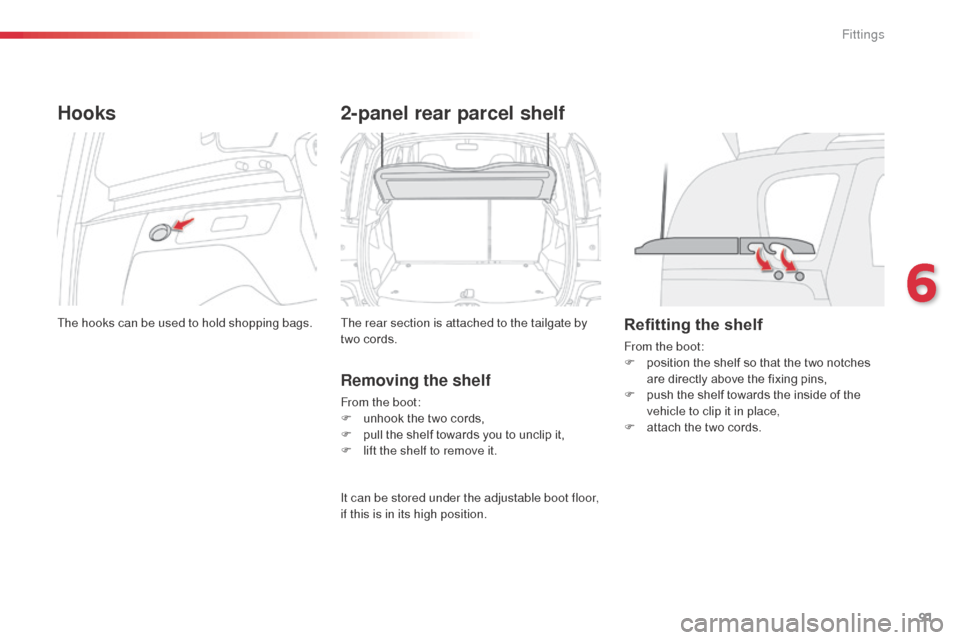
91
Hooks
The hooks can be used to hold shopping bags.
2-panel rear parcel shelf
The rear section is attached to the tailgate by
two cords.
Removing the shelf
From the boot:
F u nhook the two cords,
F
p
ull the shelf towards you to unclip it,
F
l
ift the shelf to remove it.
Refitting the shelf
From the boot:
F p osition the shelf so that the two notches
are directly above the fixing pins,
F
p
ush the shelf towards the inside of the
vehicle to clip it in place,
F
a
ttach the two cords.
It can be stored under the adjustable boot floor,
if this is in its high position.
6
Fittings
Page 102 of 288
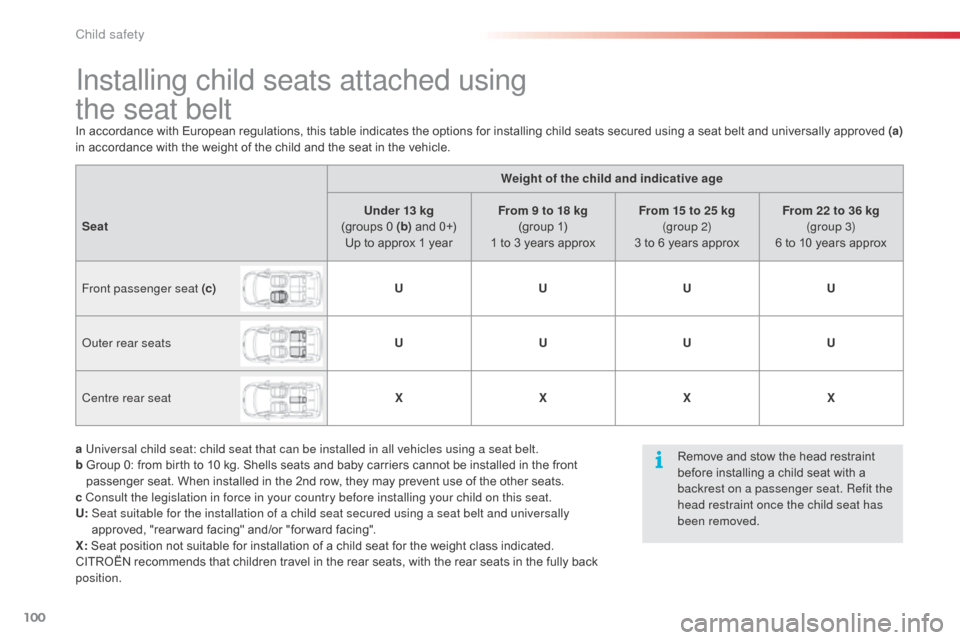
100
Installing child seats attached using
the seat belt
In accordance with European regulations, this table indicates the options for installing child seats secured using a seat belt and universally approved (a)
in accordance with the weight of the child and the seat in the vehicle.
a Universal child seat: child seat that can be installed in all vehicles using a seat belt.
b
G
roup 0: from birth to 10 kg. Shells seats and baby carriers cannot be installed in the front
passenger seat. When installed in the 2nd row, they may prevent use of the other seats.
c Consult the legislation in force in your country before installing your child on this seat.
U:
S
eat suitable for the installation of a child seat secured using a seat belt and universally
approved, "rear ward facing" and/or "for ward facing".
X:
S
eat position not suitable for installation of a child seat for the weight class indicated.
CITROËN recommends that children travel in the rear seats, with the rear seats in the fully back
position. Weight of the child and indicative age
Seat Under 13 kg
(groups 0 (b) and 0+)
Up to approx 1 year From 9 to 18 kg
(group 1)
1 to 3 years approx From 15 to 25 kg
(group 2)
3 to 6 years approx From 22 to 36 kg
(group 3)
6 to 10 years approx
Front passenger seat (c) UUUU
ou
ter rear seats UUUU
Centre rear seat XXXX
Remove and stow the head restraint
before installing a child seat with a
backrest on a passenger seat. Refit the
head restraint once the child seat has
been removed.
Child safety
Page 105 of 288
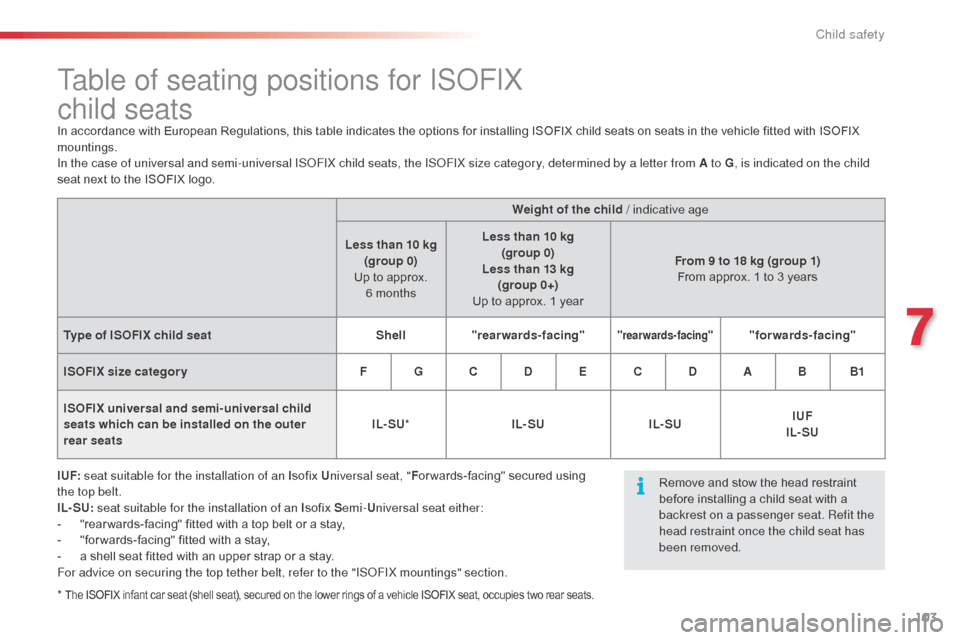
103
Table of seating positions for ISoFIX
child seats
In accordance with European Regulations, this table indicates the options for installing ISOFIX child seats on seats in the vehicle fitted with ISOFIX
mountings.
In the case of universal and semi-universal IS
oF
IX child seats, the IS
oF
IX size category, determined by a letter from A to G, is indicated on the child
seat next to the ISOFIX logo.
I UF: seat suitable for the installation of an I sofix Universal seat, " For wards-facing" secured using
the top belt.
IL- SU: seat suitable for the installation of an I sofix Semi-Universal seat either:
-
"
rear wards-facing" fitted with a top belt or a stay,
-
"
for wards-facing" fitted with a stay,
-
a s
hell seat fitted with an upper strap or a stay.
For advice on securing the top tether belt, refer to the " I
SoFI
X
m
ountings" section.
*
The ISOFIX infant car seat (shell seat), secured on the lower rings of a vehicle ISOFIX seat, occupies two rear seats.
Weight of the child / indicative age
Less than 10 kg (group 0)
Up to approx. 6
months Less than 10 kg
(group 0)
Less than 13 kg (group 0+)
Up to approx. 1 year From 9 to 18 kg (group 1)
From approx. 1 to 3 years
Type of ISOFIX child seat Shell"rearwards-facing"
"rearwards-facing""forwards-facing"
ISOFIX size categor y F G C D E C D A B B1
ISOFIX universal and semi-universal child
seats which can be installed on the outer
rear seats IL- SU
* IL- SU IL- SU IUF
IL- SU
Remove and stow the head restraint
before installing a child seat with a
backrest on a passenger seat. Refit the
head restraint once the child seat has
been removed.
7
Child safety
Page 108 of 288
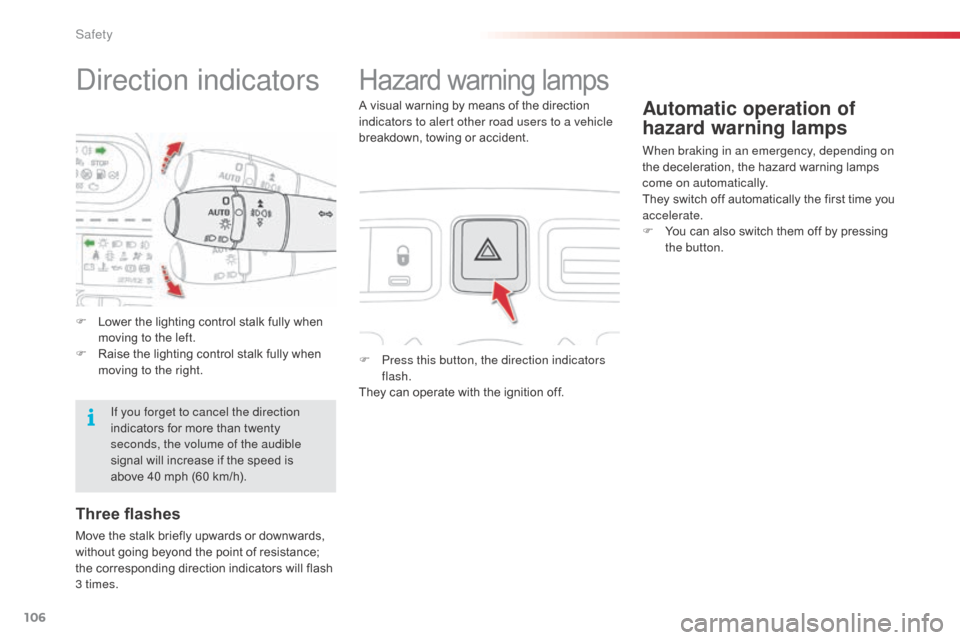
106
direction indicatorsHazard warning lamps
F Press this button, the direction indicators flash.
They can operate with the ignition off.
Automatic operation of
hazard warning lamps
When braking in an emergency, depending on
the deceleration, the hazard warning lamps
come on automatically.
They switch off automatically the first time you
accelerate.
F
Y
ou can also switch them off by pressing
the button.
Three flashes
Move the stalk briefly upwards or downwards,
without going beyond the point of resistance;
the corresponding direction indicators will flash
3 times. A visual warning by means of the direction
indicators to alert other road users to a vehicle
breakdown, towing or accident.
F
L
ower the lighting control stalk fully when
moving to the left.
F
R
aise the lighting control stalk fully when
moving to the right.
If you forget to cancel the direction
indicators for more than twenty
seconds, the volume of the audible
signal will increase if the speed is
above 40 mph (60 km/h).
Safety
Page 119 of 288
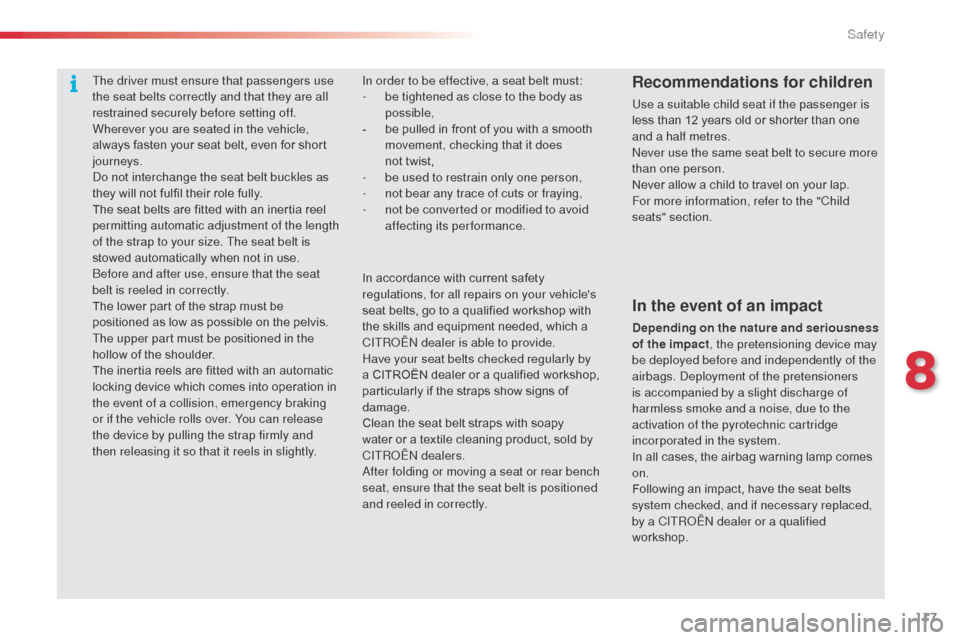
117
In order to be effective, a seat belt must:
- b e tightened as close to the body as
possible,
-
b
e pulled in front of you with a smooth
movement, checking that it does
not
twist,
-
b
e used to restrain only one person,
-
n
ot bear any trace of cuts or fraying,
-
n
ot be converted or modified to avoid
affecting its performance.
In accordance with current safety
regulations, for all repairs on your vehicle's
seat belts, go to a qualified workshop with
the skills and equipment needed, which a
CITR
oËn
dealer is able to provide.
Have your seat belts checked regularly by
a CITROËN dealer or a qualified workshop,
particularly if the straps show signs of
damage.
Clean the seat belt straps with soapy
water or a textile cleaning product, sold by
CITR
oËn d
ealers.
af
ter folding or moving a seat or rear bench
seat, ensure that the seat belt is positioned
and reeled in correctly.Recommendations for children
Use a suitable child seat if the passenger is
less than 12 years old or shorter than one
and a half metres.
ne
ver use the same seat belt to secure more
than one person.
Never allow a child to travel on your lap.
For more information, refer to the "Child
seats" section.
In the event of an impact
Depending on the nature and seriousness
of the impact , the pretensioning device may
be deployed before and independently of the
airbags.
d
ep
loyment of the pretensioners
is accompanied by a slight discharge of
harmless smoke and a noise, due to the
activation of the pyrotechnic cartridge
incorporated in the system.
In all cases, the airbag warning lamp comes
on.
Following an impact, have the seat belts
system checked, and if necessary replaced,
by a CITR
oËn
dealer or a qualified
workshop.
The driver must ensure that passengers use
the seat belts correctly and that they are all
restrained securely before setting off.
Wherever you are seated in the vehicle,
always fasten your seat belt, even for short
journeys.
do n
ot interchange the seat belt buckles as
they will not fulfil their role fully.
The seat belts are fitted with an inertia reel
permitting automatic adjustment of the length
of the strap to your size. The seat belt is
stowed automatically when not in use.
be
fore and after use, ensure that the seat
belt is reeled in correctly.
The lower part of the strap must be
positioned as low as possible on the pelvis.
The upper part must be positioned in the
hollow of the shoulder.
The inertia reels are fitted with an automatic
locking device which comes into operation in
the event of a collision, emergency braking
or if the vehicle rolls over. You can release
the device by pulling the strap firmly and
then releasing it so that it reels in slightly.
8
Safety
Page 120 of 288
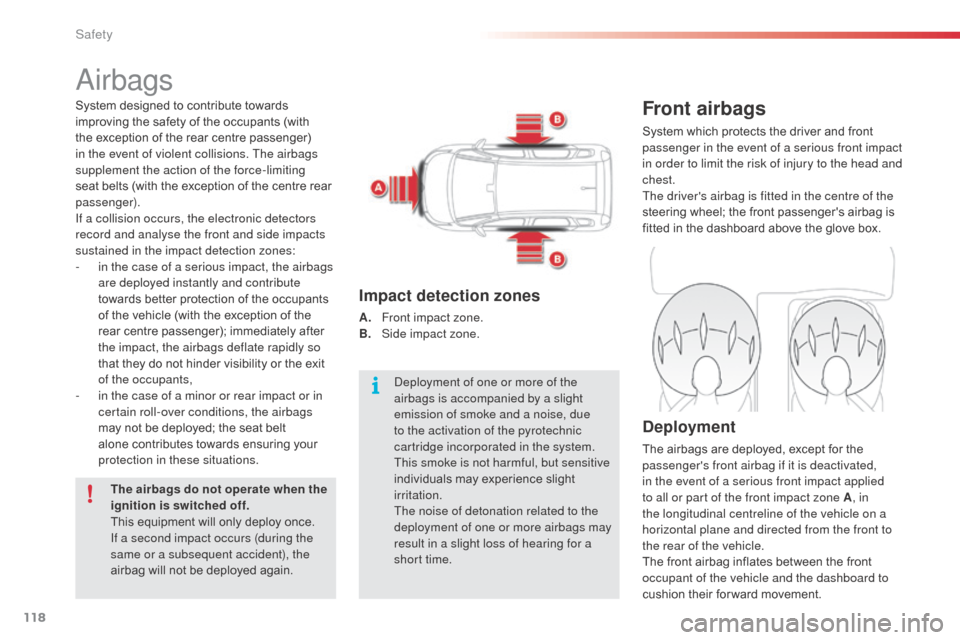
118
airbags
Front airbags
System which protects the driver and front
passenger in the event of a serious front impact
in order to limit the risk of injury to the head and
chest.
The driver's airbag is fitted in the centre of the
steering wheel; the front passenger's airbag is
fitted in the dashboard above the glove box.
Deployment
The airbags are deployed, except for the
passenger's front airbag if it is deactivated,
in the event of a serious front impact applied
to all or part of the front impact zone A, in
the longitudinal centreline of the vehicle on a
horizontal plane and directed from the front to
the rear of the vehicle.
The front airbag inflates between the front
occupant of the vehicle and the dashboard to
cushion their for ward movement.
Impact detection zones
A. Front impact zone.
B. S ide impact zone.
System designed to contribute towards
improving the safety of the occupants (with
the exception of the rear centre passenger)
in the event of violent collisions. The airbags
supplement the action of the force-limiting
seat belts (with the exception of the centre rear
passenger).
If a collision occurs, the electronic detectors
record and analyse the front and side impacts
sustained in the impact detection zones:
-
i
n the case of a serious impact, the airbags
are deployed instantly and contribute
towards better protection of the occupants
of the vehicle (with the exception of the
rear centre passenger); immediately after
the impact, the airbags deflate rapidly so
that they do not hinder visibility or the exit
of the occupants,
-
i
n the case of a minor or rear impact or in
certain roll-over conditions, the airbags
may not be deployed; the seat belt
alone contributes towards ensuring your
protection in these situations.
The airbags do not operate when the
ignition is switched off.
This equipment will only deploy once.
If a second impact occurs (during the
same or a subsequent accident), the
airbag will not be deployed again.
de
ployment of one or more of the
airbags is accompanied by a slight
emission of smoke and a noise, due
to the activation of the pyrotechnic
cartridge incorporated in the system.
This smoke is not harmful, but sensitive
individuals may experience slight
irritation.
The noise of detonation related to the
deployment of one or more airbags may
result in a slight loss of hearing for a
short time.
Safety
Page 122 of 288
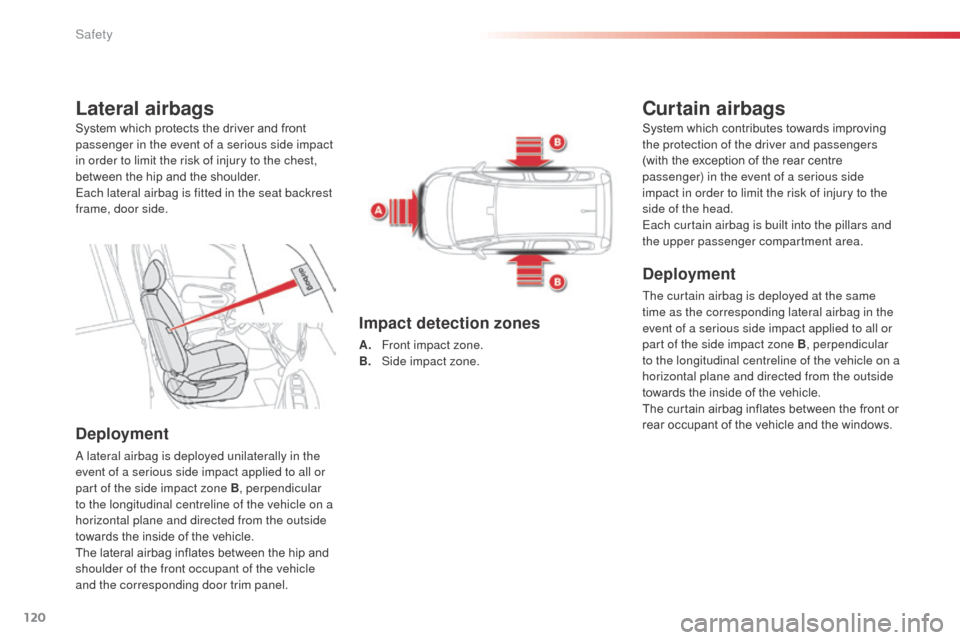
120
Lateral airbags
Deployment
a lateral airbag is deployed unilaterally in the
e vent of a serious side impact applied to all or
part of the side impact zone B, perpendicular
to the longitudinal centreline of the vehicle on a
horizontal plane and directed from the outside
towards the inside of the vehicle.
The lateral airbag inflates between the hip and
shoulder of the front occupant of the vehicle
and the corresponding door trim panel.
Curtain airbags
Deployment
The curtain airbag is deployed at the same
time as the corresponding lateral airbag in the
event of a serious side impact applied to all or
part of the side impact zone B, perpendicular
to the longitudinal centreline of the vehicle on a
horizontal plane and directed from the outside
towards the inside of the vehicle.
The curtain airbag inflates between the front or
rear occupant of the vehicle and the windows.
Impact detection zones
A. Front impact zone.
B. S ide impact zone.
System which protects the driver and front
passenger in the event of a serious side impact
in order to limit the risk of injury to the chest,
between the hip and the shoulder.
Each lateral airbag is fitted in the seat backrest
frame, door side.
System which contributes towards improving
the protection of the driver and passengers
(with the exception of the rear centre
passenger) in the event of a serious side
impact in order to limit the risk of injury to the
side of the head.
Each curtain airbag is built into the pillars and
the upper passenger compartment area.
Safety
Page 139 of 288
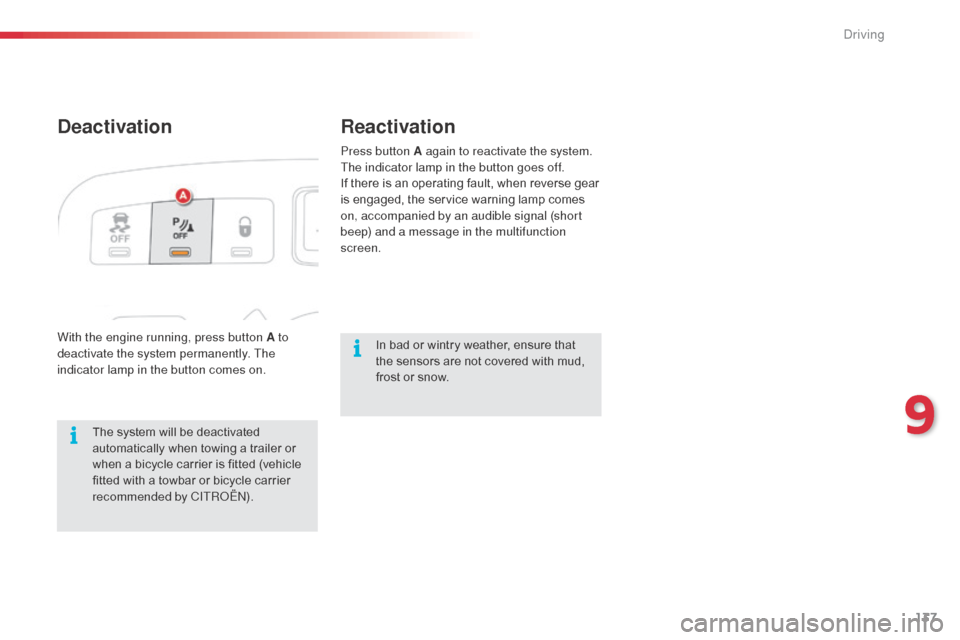
137
DeactivationReactivation
With the engine running, press button A to
deactivate the system permanently. The
indicator lamp in the button comes on.
The system will be deactivated
automatically when towing a trailer or
when a bicycle carrier is fitted (vehicle
fitted with a towbar or bicycle carrier
recommended by CITR
oËn)
.In bad or wintry weather, ensure that
the sensors are not covered with mud,
frost or snow.
Press button A again to reactivate the system.
The indicator lamp in the button goes off.
If there is an operating fault, when reverse gear
is engaged, the service warning lamp comes
on, accompanied by an audible signal (short
beep) and a message in the multifunction
screen.
9
Driving
Page 141 of 288
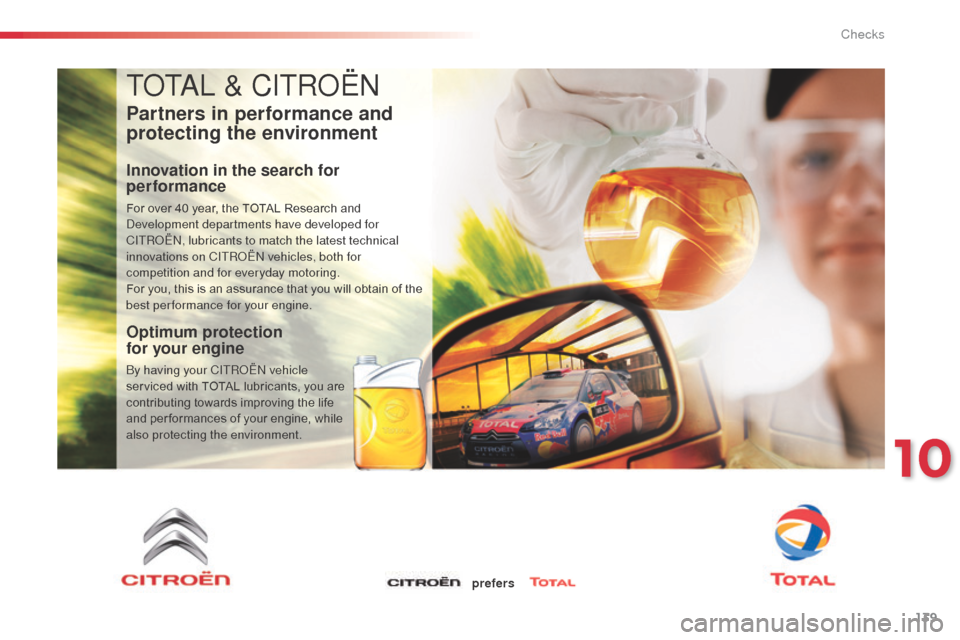
139
ToTaL & CITRoËn
Partners in performance and
protecting the environment
Innovation in the search for
performance
For over 40 year, the TOTAL Research and development departments have developed for
CITR
oËn, l
ubricants to match the latest technical
innovations on CITR
oËn
vehicles, both for
competition and for everyday motoring.
For you, this is an assurance that you will obtain of the
best performance for your engine.
Optimum protection
for your engine
by having your CITRoËn vehicle
serviced with TOTAL lubricants, you are
contributing towards improving the life
and per formances of your engine, while
also protecting the environment.
prefers
10
Checks